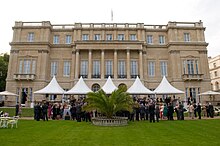The 10th G7 Summit was held in London, England, United Kingdom from 7 to 9 June 1984. The venue for the summit meetings was Lancaster House in London.[1]
| 10th G7 summit | |
|---|---|
 Lancaster House in London | |
| Host country | United Kingdom |
| Dates | June 7–9, 1984 |
| Venue(s) | Lancaster House |
| Cities | London, England |
| Follows | 9th G7 summit |
| Precedes | 11th G7 summit |
The Group of Seven (G7) was an unofficial forum which brought together the heads of the richest industrialized countries: France, West Germany, Italy, Japan, the United Kingdom, the United States, Canada (since 1976),[2] and the President of the European Commission (starting officially in 1981).[3] The summits were not meant to be linked formally with wider international institutions; and in fact, a mild rebellion against the stiff formality of other international meetings was a part of the genesis of cooperation between France's president Valéry Giscard d'Estaing and West Germany's chancellor Helmut Schmidt as they conceived the first Group of Six (G6) summit in 1975.[4]
Leaders at the summit
editThe G7 is an unofficial annual forum for the leaders of Canada, the European Commission, France, Germany, Italy, Japan, the United Kingdom and the United States.[3]
The 10th G7 summit was the first summit for Italian Prime Minister Bettino Craxi. It was also the last summit for Canadian Prime Minister Pierre Trudeau.
Participants
editThese summit participants are the current "core members" of the international forum:[5][1][6]
| Core G7 members Host state and leader are shown in bold text. | |||
| Member | Represented by | Title | |
|---|---|---|---|
| Canada | Pierre Trudeau | Prime Minister | |
| France | François Mitterrand | President | |
| West Germany | Helmut Kohl | Chancellor | |
| Italy | Bettino Craxi | Prime Minister | |
| Japan | Yasuhiro Nakasone | Prime Minister | |
| United Kingdom | Margaret Thatcher | Prime Minister | |
| United States | Ronald Reagan | President | |
| European Community | Gaston Thorn | Commission President | |
| François Mitterrand | Council President | ||
Issues
editThe summit was intended as a venue for resolving differences among its members. As a practical matter, the summit was also conceived as an opportunity for its members to give each other mutual encouragement in the face of difficult economic decisions.[4] Issues which were discussed at this summit included:
- economic problems, prospects, and opportunities for countries and for the world
- world recession
- enduring growth and the creation of new jobs
- growing strain of public expenditure
- unemployment
- political and economic challenges for developing countries
- debt burdens of developing countries and role for the International Monetary Fund (IMF)
- policies to reduce inflation and interest rates
- control monetary growth and reduce budgetary deficits
- business innovations
- labour issues and opportunities
- economic stability and management
- development assistance and assistance through the international financial and development institutions to the developing countries
- third world debt
- trade liberalization
- poverty and drought
- oil and the Persian Gulf
- the Eastern Bloc
- job creation innovations in Italy
- the environment
- manned space stations
Gallery of participating leaders
editCore G7 participants
editSee also
editNotes
edit- ^ a b Japan, Ministry of Foreign Affairs (MOFA): Summit Meetings in the Past.
- ^ Saunders, Doug. "Weight of the world too heavy for G8 shoulders," Archived 2008-10-11 at the Wayback Machine Globe and Mail (Toronto). July 5, 2008 -- n.b., the G7 becomes the Group of Eight (G7) with the inclusion of Russia starting in 1997.
- ^ a b Reuters: "Factbox: The Group of Eight: what is it?", July 3, 2008.
- ^ a b Reinalda, Bob and Bertjan Verbeek. (1998). Autonomous Policy Making by International Organizations, p. 205.
- ^ Rieffel, Lex. "Regional Voices in Global Governance: Looking to 2010 (Part IV)," Archived 2010-06-03 at the Wayback Machine Brookings. March 27, 2009; "core" members (Muskoka 2010 G-8, official site). Archived June 2, 2010, at the Wayback Machine
- ^ MOFA: Summit (10); European Union: "EU and the G8" Archived 2007-02-26 at the Wayback Machine
References
edit- Bayne, Nicholas and Robert D. Putnam. (2000). Hanging in There: The G7 and G8 Summit in Maturity and Renewal. Aldershot, Hampshire, England: Ashgate Publishing. ISBN 978-0-7546-1185-1; OCLC 43186692 (Archived 2009-04-29)
- Reinalda, Bob and Bertjan Verbeek. (1998). Autonomous Policy Making by International Organizations. London: Routledge. ISBN 978-0-415-16486-3; ISBN 978-0-203-45085-7; OCLC 39013643
External links
edit- No official website is created for any G7 summit prior to 1995 -- see the 21st G7 summit.
- University of Toronto: G8 Research Group, G8 Information Centre